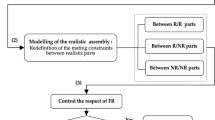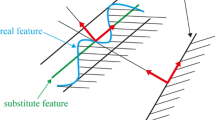Abstract
In industrial contexts, overconstrained assemblies are often used to ensure sufficient stiffness and accuracy of assembly. Such architectures are quite usual, however, analysis and synthesis of the tolerance are not easy to define and quantify. In these cases, the compliance of the assembly is not automatic and deformations may often occur, requiring a particular and difficult analysis of the assembly from scientific and computing points of view.The present work addresses such overconstrained mechanisms through a general and a sequential approach. Based on this, it is possible to determine the final assembly condition (with or without interference) as a function of part defects. First, the assembly procedure is performed based on polytope computations, assuming a rigid part behavior. From this, a stochastic simulation is performed and some non-compliant assemblies (assemblies with interferences) are identified. For these assemblies, the rigid behavior of parts is then overcome by means of finite element simulations and a typical procedure is set up to introduce part defects. We then deduce whether the assembly can be made from the load needed to assemble the parts. This procedure is applied to a flange composed of five pin/hole pairs, as this is a highly overconstrained mechanism.







Similar content being viewed by others
Abbreviations
- \(\mathbf {t_{M-1,i/2,i}}\) :
-
Translation vector of surface i of part 1 in relation to surface i of part 2 at point M. If \(i=0\), we are considering the translation of the nominal geometry of part 1 in relation to the nominal geometry of part 2 at point M
- \(\mathbf {r_{1,i/2,i}}\) :
-
Rotation vector of surface i of part 1 in relation to surface i of part 2. If \(i=0\), we are considering the rotation of the nominal geometry of part 1 in relation to the nominal geometry of part 2
- \(\mathbf {e_{M-1,i/1,0}}\) :
-
Location defect vector of surface i of part 1 in relation to its nominal geometry at point M
- \(\mathbf {e_{M-2,i/2,0}}\) :
-
Location defect vector of surface i of part 2 in relation to its nominal geometry at point M
- \(D_{n}\), \(D_{1,i}\) and \(D_{2,i}\) :
-
The diameter of the nominal surface, the diameters of surface i of part 1 and surface i of part 2 respectively
- \(\overline{H}_{i,j}^-\) :
-
Half-space of the contact constraint derived from the jth discretization point between surface i of part 1 and surface i of part 2,
- \(P_{i}\) :
-
Contact polytope of surface i of part 1 in relation to surface i of part 2
- \(P_{R}\) :
-
Resulting contact polytope of part 1 in relation to part 2
References
Ameta G, Davidson JK, Shah JJ (2007) Using tolerance-maps to generate frequency distributions of clearance and allocate tolerances for pin-hole assemblies. J Comput Inf Sci Eng 7(4):347–359
Ameta G, Samper S, Giordano M (2011) Comparison of spatial math models for tolerance analysis: tolerance-maps, deviation domain, and TTRS. J Comput Inf Sci Eng 11:1–8
Anselmetti B (2010) CLIC: a method for geometric specification of products. In: Geometric tolerancing of products, ISBN 978-1-84821-118-6, ISTE-WILEY, pp 210–239
Arroyave Tobon S, Teissandier D, Delos V (2016) Tolerance analysis with polytopes in HV-description. IDETC201659027, Charlotte (North Carolina - USA)
Beaucaire P, Gayton N, Duc E, Dantan JY (2013) Statistical tolerance analysis of over-constrained mechanisms with gaps using system reliability methods. Comput Aided Des 45(12):1547–1555. doi:10.1016/j.cad.2013.06.011
Bourdet P, Clément A (1988) A study of optimal-criteria identification based on the small-displacement screw model. CIRP Ann-Manuf Technol 37(1):503–506
Bourdet P, Mathieu L, Lartigue C, Ballu A (1996) The concept of the small displacement torsor in metrology. Series Adv Math Appl Sci Adv Math Tools Metrol II 40:110–122
Breteau P, Thiebaut F, Lartigue C, Fricro B, Falgarone H, Moufle GE (2007) Assembly simulation of flexible parts through the fitting of linkage devices. In: 10th CIRP conference on computer aided tolerancing, Erlangen, Germany
Chevassus N, Falgarone H, Thiebaut F, Bourdet P, Moufle GE (2006) A new approach for best fit assembly based on the behaviour of components (No. 2006-01-3174). SAE Technical Paper.
Cid G, Thiebaut F, Bourdet P, Falgarone H (2007) Geometrical study of assembly behaviour, taking into accounts rigid components deviations, actual geometric variations and deformations. In: Davidson JK (ed) Models for computer aided tolerancing in design and manufacturing. Springer, The Netherlands, pp 301–310
Dantan JY, Qureshi AJ (2009) Worst-case and statistical tolerance analysis based on quantified constraint satisfaction problems and Monte Carlo simulation. Comput Aided Des 41(1):1–12. doi:10.1016/j.cad.2008.11.003
Davidson JK, Mujezinovic A, Shah JJ (2002) A new mathematical model for geometric tolerances as applied to round faces. ASME Trans J Mech Des 124:609–622
DCS (2011) DCS-tolerance analysis, GD&T, and quality solutions. www.3dcs.com
Delos V, Teissandier D (2015) PolitoCAT and Politopix. http://i2m.u-bordeaux.fr/politopix.html
Fleming A (1988) Geometric relationships between toleranced features. Artif Intell 37(1–3):403–412
Giordano M, Duret D, Tichadou S, Arrieux R (1992) Clearance space in volumic dimensioning. Ann CIRP 41(1):565–568
Gouyou D, Teissandier D, Delos V (2016) Tolerance analysis by polytopes: application to assembly interferences diagnosis. In: 14th CIRP CAT 2016—CIRP conference on computer aided tolerancing, vol 43, pp 52–57. doi:10.1016/j.procir.2016.02.019
Hibbitt D, Karlsson B, Sorensen P (2011) ABAQUS 6.11: a computer software for finite element analysis
Hu JS, Camelio J (2006) Modeling and control compliant assembly systems. Ann CIRP Manuf Technol 55(1):19–22
ISO5459 (2011) Geometrical tolerancing—datums and datum systems
Jaishankar LN, Davidson JK, Shah JJ (2012) Representing stresses that arise in parallel assemblies that contain imperfect geometry allowed by tolerances. ASME, pp 577–584. doi:10.1115/DETC2012-70208
Jaishankar LN, Davidson JK, Shah JJ (2013) Tolerance analysis of parallel assemblies using tolerance-maps and a functional map derived from induced deformations. ASME. doi:10.1115/DETC2013-12394
Ledoux Y, Teissandier D (2013) Geometric variability analysis by a fiabilist approach: application to a turbine. Res Eng Des 24(3):297–311
Mansuy M, Giordano M, Davidson JK (2013a) Comparison of two similar mathematical models for tolerance analysis: T-map and deviation domain. J Mech Des 135(10):101008. doi:10.1115/1.4024980
Mansuy M, Giordano M, Hernandez P (2013b) A generic method for the worst case and statistical tridimensional tolerancing analysis. Proc CIRP 10:276–282
MECAmaster SARL (2012) MECAmaster assembly software. http://www.mecamaster.com
Mounaud M, Thiebaut F, Bourdet P, Falgarone H, Chevassus N (2007) Integrating the flexibility of components in the assembly of aeronautics hydraulic systems. In: 10th CIRP conference on computer aided tolerancing, Erlangen, Germany
Nigam SD, Turner JU (1995) Review of statistical approaches to tolerance analysis. Comput-Aided Des 27(1):6–15
Pezzuti E, Piscopo G, Ubertini A, Valentini PP (2005) Investigation on pin-hole connection in flexible assembly
Pierre L, Teissandier D, Nadeau JP (2014) Variational tolerancing analysis taking thermomechanical strains into account: application to a high pressure turbine. Mech Mach Theory 74:82–101. doi:10.1016/j.mechmachtheory.2013.11.014
Pottier T, Toussaint F, Vacher P (2011) Contribution of heterogeneous strain field measurements and boundary conditions modelling in inverse identification of material parameters. Eur J Mech A/Solids 30(3):373–382
Samper S, Giordano M (2003) Simultaneous analysis method for tolerancing flexible mechanisms. Book geometric product specification and verification: integration of functionality, pp 127–134
Schonherr S (2002) Quadratic programming in geometric optimization: theory, implementation and applications. PhD thesis, École polytechnique fédérale de Lausanne
Shah JJ, Ameta G, Shen Z, Davidson JK (2007) Navigating the tolerance analysis maze. Comput-Aided Des Appl 4(5):705–718
Shiu BW, Apley DW, Ceglarek D, Shi J (2003) Tolerance allocation for compliant beam structure assemblies. IIE Trans 35(4):329–342
Soderberg R, Lindkvist L, Dahlstrm S (2006) Computer-aided robustness analysis for compliant assemblies. J Eng Des 17:411–428
Teissandier D, Delos V, Coutard Y (1999) Operations on polytopes: application to tolerance analysis. In: Global consistency of tolerances, ISBN 0-7923-5654-3. Kluwer academic publisher, Enschede (Netherlands), pp 425–433
Turner JU (1993) A feasibility space approach for automated tolerancing. J Eng Ind 115:341–346
Tyson J, Schmidt T, Galanulis K (2002) Biomechanics deformation and strain measurements with 3d image correlation photogrammetry. Exp Techn 26(5):39–42
Xie K, Wells L, Camelio JA, Young BD (2007) Variation propagation analysis on compliant assemblies considering contact interaction. J Manuf Sci Eng 129(5):934–942
Author information
Authors and Affiliations
Corresponding author
Rights and permissions
About this article
Cite this article
Gouyou, D., Ledoux, Y., Teissandier, D. et al. Tolerance analysis of overconstrained and flexible assemblies by polytopes and finite element computations: application to a flange. Res Eng Design 29, 55–66 (2018). https://doi.org/10.1007/s00163-017-0256-5
Received:
Accepted:
Published:
Issue Date:
DOI: https://doi.org/10.1007/s00163-017-0256-5




